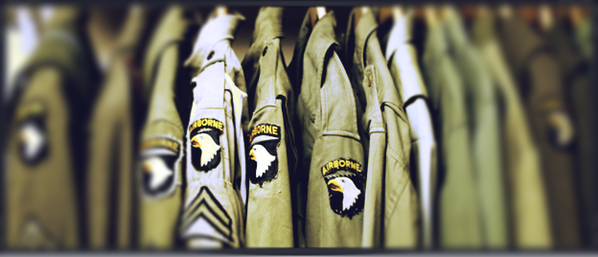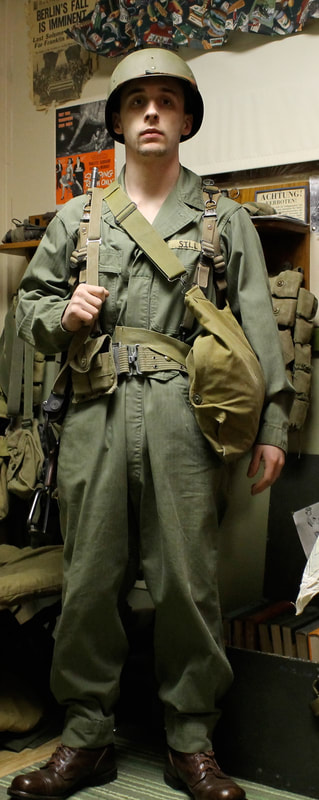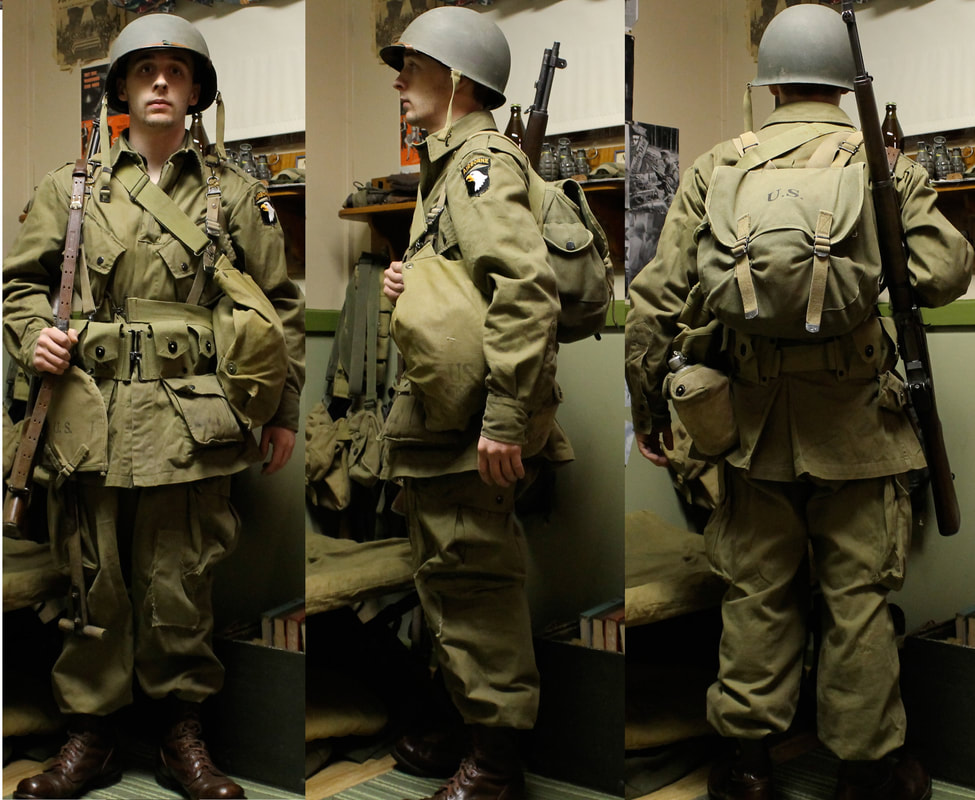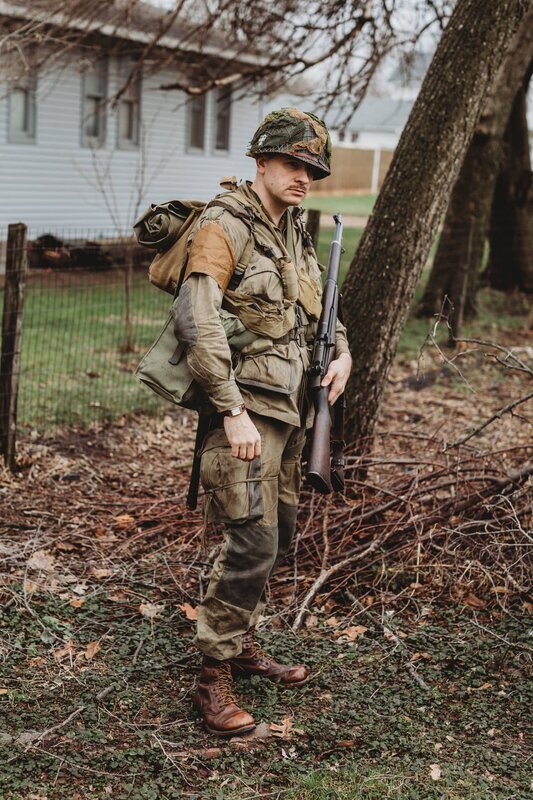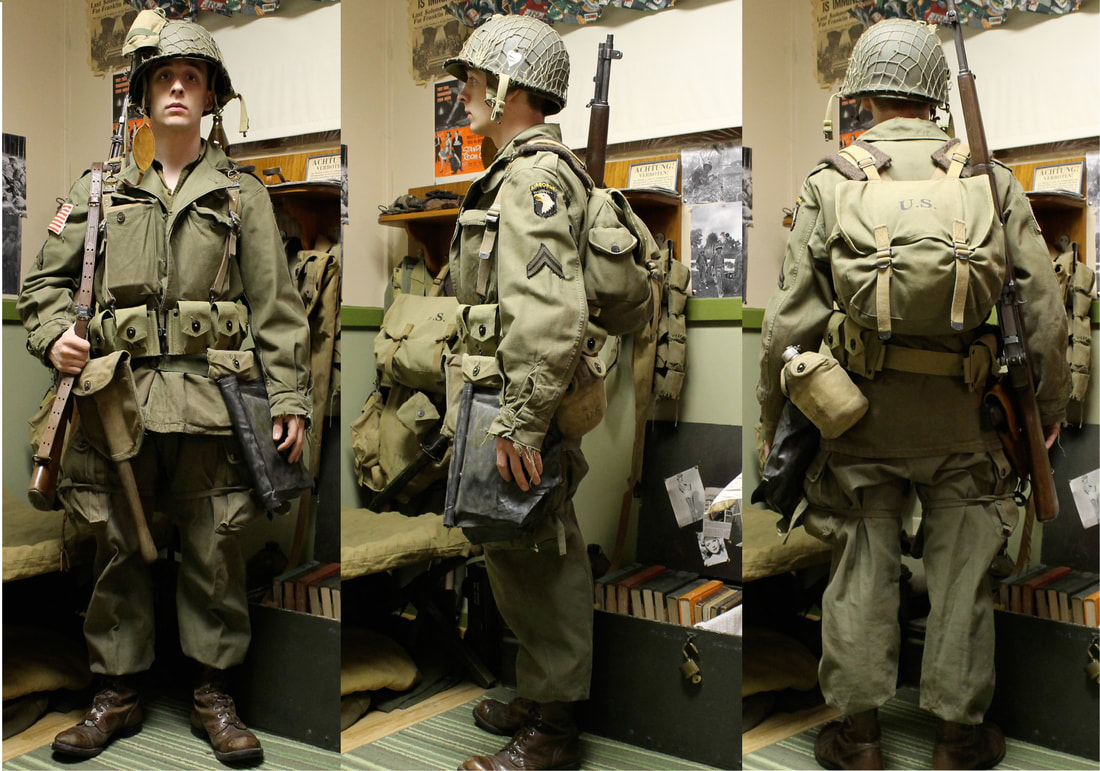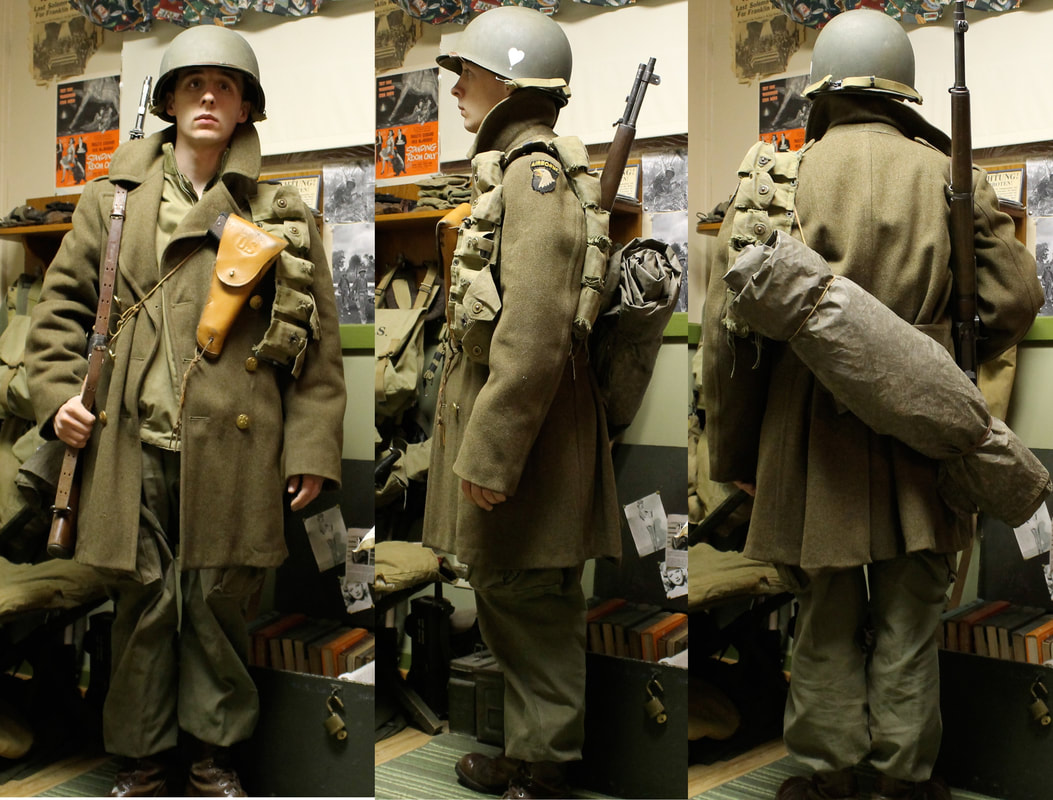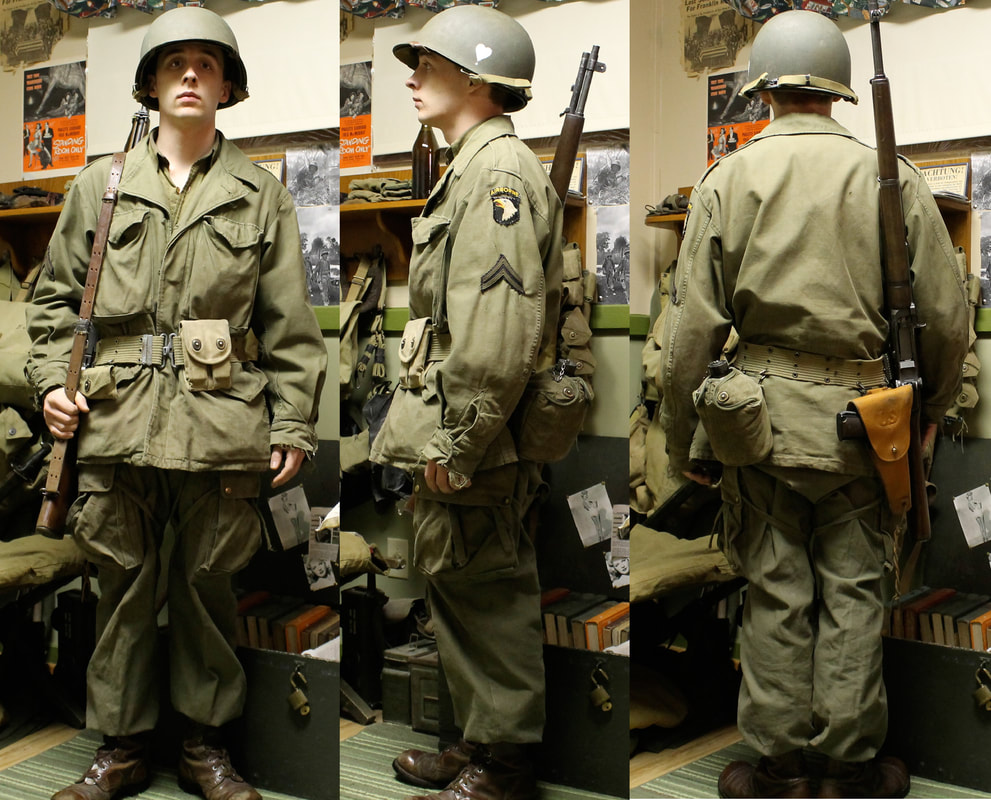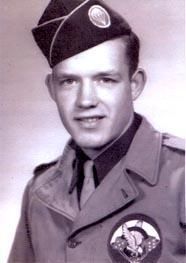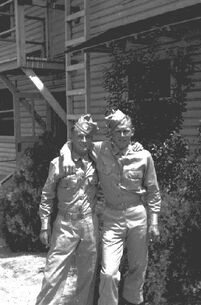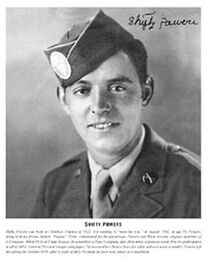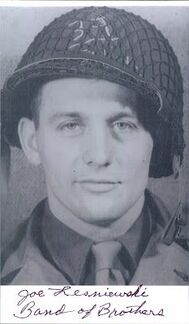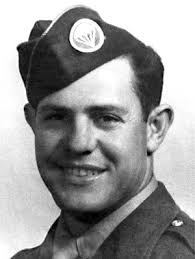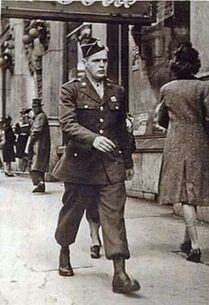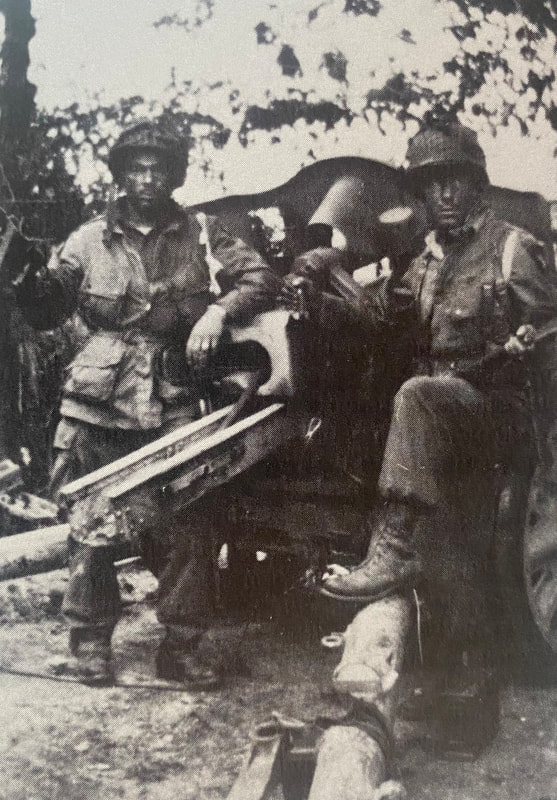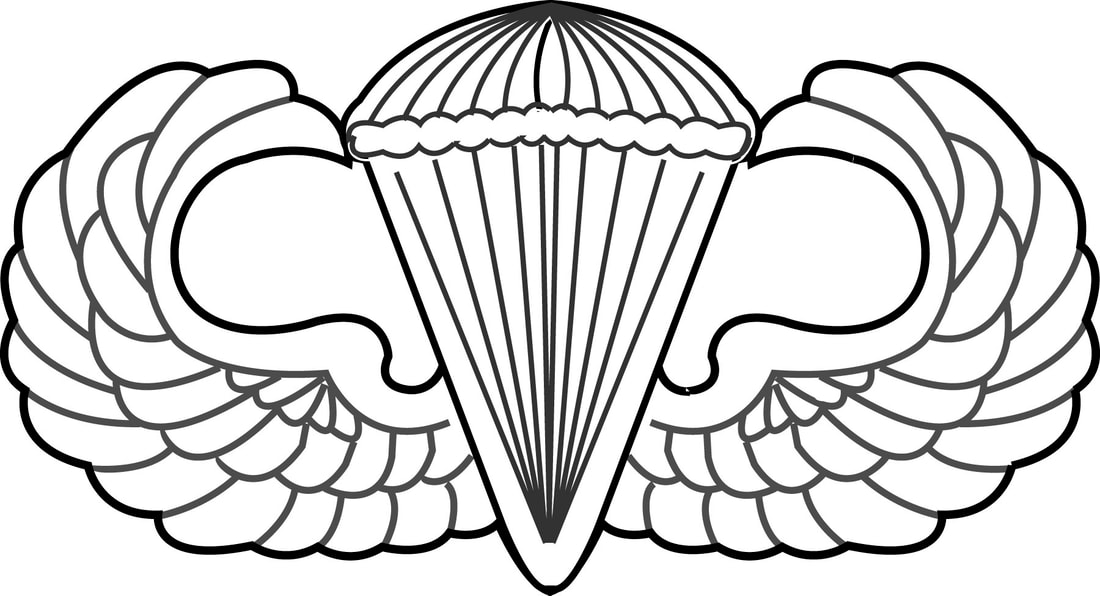Impressions and Gear of the 502nd in WWII
What Equipment should I get and when?
NEW tROOPER
• Jump Jacket, M42 Reinforced w/ 101st division patch on left sleeve
• Jump Pants, M42 Reinforced
• Wool Shirt
• Tank top (green, period correct only)
• Jump Boots, Corcoran style Brown boots
• Garrison, PX or Overseas Cap with parachute infantry cap patch
This list is intentionally small for a new trooper to the Unit. Much of an Airborne impression can be loaned, borrowed or rented. The hardest elements are the trademark Paratrooper Jump boots, as they are the most expensive to purchase and most guys only have 1 pair and borrowing boots in your size in next to impossible. Next is the M42 uniform. If you are a bigger guy or a smaller guy, you may not find a someone in the Unit your exact size so buying the uniform is a great investment. Work with your Unit Battle Buddy to see what is realistic for you to buy or what may be borrowed for your 1st year with Fox Company. A good tip would also be to bring a cot and a sleeping bag. Modern versions are allowed to bring but MUST be folded up and put away while the public are at the event.
• Jump Pants, M42 Reinforced
• Wool Shirt
• Tank top (green, period correct only)
• Jump Boots, Corcoran style Brown boots
• Garrison, PX or Overseas Cap with parachute infantry cap patch
This list is intentionally small for a new trooper to the Unit. Much of an Airborne impression can be loaned, borrowed or rented. The hardest elements are the trademark Paratrooper Jump boots, as they are the most expensive to purchase and most guys only have 1 pair and borrowing boots in your size in next to impossible. Next is the M42 uniform. If you are a bigger guy or a smaller guy, you may not find a someone in the Unit your exact size so buying the uniform is a great investment. Work with your Unit Battle Buddy to see what is realistic for you to buy or what may be borrowed for your 1st year with Fox Company. A good tip would also be to bring a cot and a sleeping bag. Modern versions are allowed to bring but MUST be folded up and put away while the public are at the event.
aFTER 2 YEARS
After 2 years with Fox Company, your goal should be to a full battle ready (D-Day) troopers. We made this a two year goal as buying a rifle can be an extreme financial burden and needs to be saved up for to obtain. Many of the items below can be obtained on the cheap at surplus stores, used, on sale at vendors, or purchased through many facebook group sites. A trooper doesn't need to wait until the 2 year mark to obtain these items but they are simply encouraged.
• Helmet, M1C w/M2 liner (airborne) w/ leather chin cup
• Helmet Net, 1/2" weave or Smaller (varies depending on timeframe of event)
• Combat Suspenders, M1936
• Musette Bag, M1936
• Cartridge Belt, M1923 or Pistol Below with 4 Rigger pouches (this is required for D-Day impressions)
• Felt Shoulder Pads for M1936 Suspenders
• First Aid Pouch, belt w/Carlisle bandage (Tie on model bandage is alternate)
• Canteen, Cup, and Cover, M1910
• Entrenching Tool w/Cover, M1910 (short or long) or 1943 Entrenching Tool w/cover
• Garrison Cap (Overseas Cap) w/Para patch
• Cricket
• Belt, Trousers w/open face buckle or suspenders
• Rifle, M1 Garand w/ sling (leather or web)
• Enblocks (M1 Garand Clips) Minimum of ten
• Bandoleer, Cotton, OD, M1 for Garand
• Mess Kit w/Knife, fork, spoon
• Dog Tags (Notched)
• Wooden Cot, Canvas, Folding W/Wood Frame (Green or White Canvas)
• Wool Blanket
• Sleeping bag (appropriate WWII era version)
- Field Jacket, M1943
• Pants, M1943 (Paratrooper-Cargo Pockets)
• Double Buckle Boots
• Helmet, M1C w/M2 liner (airborne) w/ leather chin cup
• Helmet Net, 1/2" weave or Smaller (varies depending on timeframe of event)
• Combat Suspenders, M1936
• Musette Bag, M1936
• Cartridge Belt, M1923 or Pistol Below with 4 Rigger pouches (this is required for D-Day impressions)
• Felt Shoulder Pads for M1936 Suspenders
• First Aid Pouch, belt w/Carlisle bandage (Tie on model bandage is alternate)
• Canteen, Cup, and Cover, M1910
• Entrenching Tool w/Cover, M1910 (short or long) or 1943 Entrenching Tool w/cover
• Garrison Cap (Overseas Cap) w/Para patch
• Cricket
• Belt, Trousers w/open face buckle or suspenders
• Rifle, M1 Garand w/ sling (leather or web)
• Enblocks (M1 Garand Clips) Minimum of ten
• Bandoleer, Cotton, OD, M1 for Garand
• Mess Kit w/Knife, fork, spoon
• Dog Tags (Notched)
• Wooden Cot, Canvas, Folding W/Wood Frame (Green or White Canvas)
• Wool Blanket
• Sleeping bag (appropriate WWII era version)
- Field Jacket, M1943
• Pants, M1943 (Paratrooper-Cargo Pockets)
• Double Buckle Boots
AFTER 4 YEARS
After 4 years the focus can be any specialty you want to pursue but expanding your impression to include the things that make your impression better. If you are wanting to be a radio operator, we would expect that you should be acquiring things to make that impression amazing. If you are a medic, get medic gear that will bring a great realism for the public. Being a regular rifleman doesn't have to be boring as there are so many great things to add from below. The only mandatory thing from the list below would be getting the M43 uniform. As we reference in the guide at the bottom of this page, the M42 was only worn during England and on D-Day in Normandy. After that the M43 was introduced until the end of the war. Many troopers converted to the M43 as their M42's were probably wrecked from constant use. Double Buckle boots are the most comfortable boot for paratroopers, although not as sexy to look at, these boots provide easy on and off freedom while giving better back support than wooden soled boots.
• Gloves, M1938 or M1942 (Leather)
• Knife, Fighting M-3, w/M8 Scabbard or M6 (Leather) Scabbard
• Let Down Rope (32')
• Poncho, Pullover W/O Hood
• Sweater, Pullover
• Jeep Cap
• Compass, Wrist (Optional)
• Shelter Half, M1923, Open End W/Poles (3), Pins (5), Rope (1)
• Ammo Bag, General Purpose w/Strap
• Scarf
• Duffel Bag or Barracks Bag
• Class A Uniform (4 pocket)
• Grenades (2)
• Bayonet, M1 Garand w/Scabbard (10 inch or 5 inch M4 Garand bayonet in 10 inch scabbard)
• Folding Knife
• Wire Cutter w/Case
• Hatchet W/Case
• Parka (Pullover or Button Front)
• Overcoat, Wool
• Armband, 48 Star Flag, Pin-on Type (this is for the M43 uniform for the Market Garden Impression only)
• Gloves, M1938 or M1942 (Leather)
• Knife, Fighting M-3, w/M8 Scabbard or M6 (Leather) Scabbard
• Let Down Rope (32')
• Poncho, Pullover W/O Hood
• Sweater, Pullover
• Jeep Cap
• Compass, Wrist (Optional)
• Shelter Half, M1923, Open End W/Poles (3), Pins (5), Rope (1)
• Ammo Bag, General Purpose w/Strap
• Scarf
• Duffel Bag or Barracks Bag
• Class A Uniform (4 pocket)
• Grenades (2)
• Bayonet, M1 Garand w/Scabbard (10 inch or 5 inch M4 Garand bayonet in 10 inch scabbard)
• Folding Knife
• Wire Cutter w/Case
• Hatchet W/Case
• Parka (Pullover or Button Front)
• Overcoat, Wool
• Armband, 48 Star Flag, Pin-on Type (this is for the M43 uniform for the Market Garden Impression only)
Optional
How to wear the Gear
Below is a guide written to show the different stages of what the 502nd PIR would have worn throughout WWII and how to take basic impressions and make them info great impressions.
Basic Training / Stateside Combat Gear
This is an impression that takes extraordinarily little extra money to produce and is something fun to bring out at a training event. It is by no means a requirement for our unit (I have very seldom worn it) but it is a great addition to anyone’s overall impression.
HBT coveralls are the uniform for this impression (a side note, the guys loved HBTs and HBT coveralls for their comfort and they can be seen in photos throughout the war). A name tag is present on the left side of the chest. A key for this impression is the web gear. It is all the early war lighter shade. A metal cap canteen is used, and the kidney gas mask bag is a must. The helmet liner is worn alone, without the steel pot. T‐Handle shovels were used universally at this point of the war, as the M43 entrenching tool had not been issued yet. Boots should be the regular army service shoes, but the un-bloused jump boots will do fine.
Training prior to the Normandy invasion. England 1944
This is the uniform that would have been worn in England during the months leading up to D‐Day. It is quite different from what the guys wore when they jumped on June 6 and much of this impression will be used to demonstrate the differences between the two impressions.
Unreinforced M42s are worn, and the gear is quite minimal. A name tape should be attached to the left chest. The kidney gas mask bag was still being used at this point. Web gear is all still the lighter khaki color, minus the musette bag, which is transitional. Some transitional gear was seeping into the picture at this point, but the vast majority was still khaki. The helmet is plain, no net or scrim, and unmarked, no heart.
Unreinforced M42s are worn, and the gear is quite minimal. A name tape should be attached to the left chest. The kidney gas mask bag was still being used at this point. Web gear is all still the lighter khaki color, minus the musette bag, which is transitional. Some transitional gear was seeping into the picture at this point, but the vast majority was still khaki. The helmet is plain, no net or scrim, and unmarked, no heart.
D-Day
There is one rule when it comes to Normandy themed events, MORE. These guys were LOADED down on D‐Day. They gave paratroopers lots of pockets for a reason. We need to use them. And not just your pants pockets. Fill every pocket on your jacket to the brim with anything you can think of. If you must use non‐period filler that’s OK, but it is best to find period filler. You should basically become a walking footlocker. Shaving kits, sewing kits, rations, lots of extra socks, anything and everything. And then find some more.
Every regiment in the 101st used scrim, but it was heaviest in the 502. Next, the heart. The “tic” system to differentiate between battalions was not implemented in the 502 before Normandy. The heart is all that should be on your helmet. The lack of “tics” is why the 2nd battalion wore the white armband around their left sleeve (3rd batt wore it around their necks). Also, the nametape that was used during training needs to be removed from the uniform, unless you are an officer.
Also, regarding the uniform, PFCs did not add chevrons to their M42s during Normandy, so both Pvts and PFCs should be bare‐sleeved. Next to the gear. The most notable difference between this impression and the training impression is the use of a pistol belt and rigger pouches in lieu of a cartridge belt. Rigger pouches were by far the most common method for riflemen to carry their ammo in the 502 during Normandy. Very few cartridge belts were used.
The gear is still almost entirely khaki, and a metal cap canteen is used, as they were still far more common on D‐Day. I would like to again mention how much equipment each trooper carried. To give you an idea of how much gear should be attached to your belt, we'll lay out how much ammunition was carried into Normandy. For troopers carrying the M1 Garand, everyone jumped with 136 rounds of ammunition. Some may have carried more, but no one carried less. That is 17 enblocs full of ammo, or 4 full rigger pouches plus one in the rifle. Also, 60 riflemen per company carried one belt of LMG ammunition in addition to their own ammo. For troopers carrying the M1a1 carbine – everyone jumped with 175 rounds of ammunition. That is 12 magazines. (rounded up). Thompson SMG, everyone jumped with 300 rounds of ammunition. That is 14 20 round magazines. Hand grenades – Each individual jumped with 4. These were usually stored in a GP ammo bag or in your pockets. That should give you a fairly good handle on how many ammunition pouches you should carry.
Every regiment in the 101st used scrim, but it was heaviest in the 502. Next, the heart. The “tic” system to differentiate between battalions was not implemented in the 502 before Normandy. The heart is all that should be on your helmet. The lack of “tics” is why the 2nd battalion wore the white armband around their left sleeve (3rd batt wore it around their necks). Also, the nametape that was used during training needs to be removed from the uniform, unless you are an officer.
Also, regarding the uniform, PFCs did not add chevrons to their M42s during Normandy, so both Pvts and PFCs should be bare‐sleeved. Next to the gear. The most notable difference between this impression and the training impression is the use of a pistol belt and rigger pouches in lieu of a cartridge belt. Rigger pouches were by far the most common method for riflemen to carry their ammo in the 502 during Normandy. Very few cartridge belts were used.
The gear is still almost entirely khaki, and a metal cap canteen is used, as they were still far more common on D‐Day. I would like to again mention how much equipment each trooper carried. To give you an idea of how much gear should be attached to your belt, we'll lay out how much ammunition was carried into Normandy. For troopers carrying the M1 Garand, everyone jumped with 136 rounds of ammunition. Some may have carried more, but no one carried less. That is 17 enblocs full of ammo, or 4 full rigger pouches plus one in the rifle. Also, 60 riflemen per company carried one belt of LMG ammunition in addition to their own ammo. For troopers carrying the M1a1 carbine – everyone jumped with 175 rounds of ammunition. That is 12 magazines. (rounded up). Thompson SMG, everyone jumped with 300 rounds of ammunition. That is 14 20 round magazines. Hand grenades – Each individual jumped with 4. These were usually stored in a GP ammo bag or in your pockets. That should give you a fairly good handle on how many ammunition pouches you should carry.
Operation Market‐Garden, Holland 1944
The first thing to note (obviously) is the use of M43s. Also, note the helmet has the para first aide pouch attached to the net. This is commonly mistaken as being something that was only done during Operation Varsity, but photographic evidence shows it was very common in the 502 during Market‐Garden. This impression looks more “refined” than the D‐Day impression. After experiencing Normandy, the guys really began to figure out what equipment was essential and what could be tossed out. Rifleman almost all used cartridge belts instead of pistol belts and rigger pouches. The pockets of the uniform, however, should still be full! The American flag is attached to the right sleeve of the jacket. This was the only time during the war when the 502 employed these flags and they were very quickly discarded. They should not be worn on your M43s at any event that has a post Market‐Garden theme. Some more dark colored gear was beginning to show up by this point as well.
Battle of the Bulge Dec. 1944 – Jan. 1945
Time to get creative!
These guys were wearing anything and everything when they were thrown into the Bulge. Grow a beard; wear M41s, 43s, Mackinaws, etc. etc. As far as gear goes, think of the exact opposite of D‐Day. Go as minimal as you like. You still see photos of guys with suspenders and musette bags, but tons of guys were wearing almost nothing in the way of web gear. All I am carrying is a cartridge belt with my 45 and a little ammo. The regular cartridge belt (worn in the Market‐Garden photos) has been replaced with a beat up original. “Hobo rolls" were also incredibly common in the latter part of the war, especially in the bulge. Roll up some rations and a few other small personal items in a blanket and/or raincoat. Use spare shoelaces or bits of leather to make a shoulder strap and you are good to go.
Late war March – May 1945
This impression would have been worn post Battle of the Bulge as the 101st moved across Germany, eventually landing in and around Mittersell, Austria. We do few events with a late war theme, but the last several Dakota City events would have been an appropriate time to wear this uniform. The 101st was not in heavy combat during this time and thus dropped most of their combat gear when they were on the move. The pistol belt is worn with nothing but a .45, canteen and first aid kit. Double buckles were common during this time, as they were in the bulge and Market‐Garden. M43s were universal at this time and would have been fairly new and unused, as they would have been resupplied following the bulge.
Paratrooper Swagger
One of the easiest, cheapest and authentic things you can do when you portray a member of the 101st Airborne is to ACT like a paratrooper. Cock your helmet and garrison cap, whistle at all of the dames you cross paths with and walk with a cocky gait. These guys believed (and were) the BEST in the Army and acted like it.
